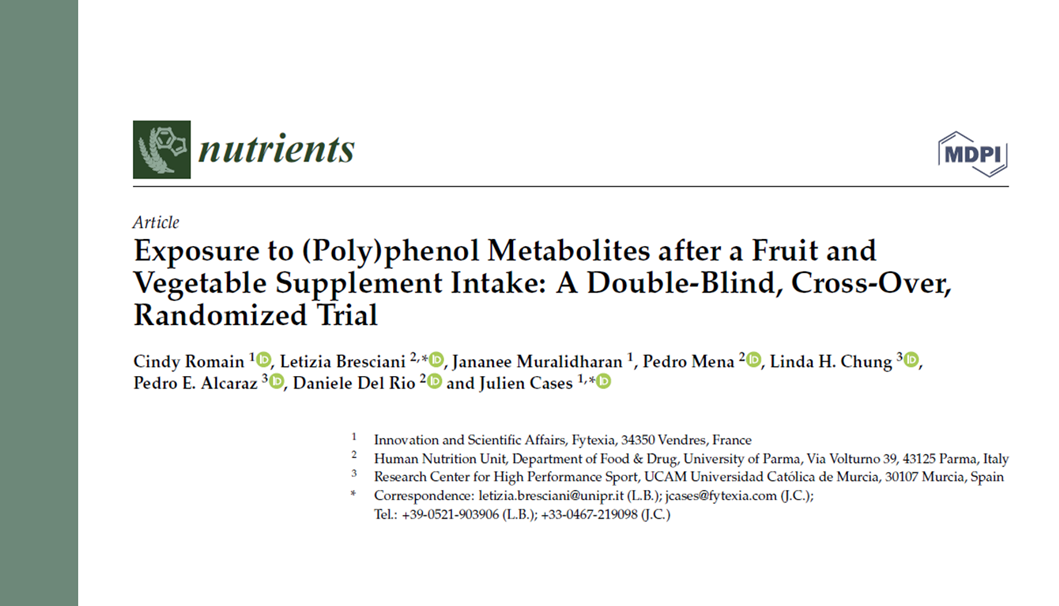New article published in the peer review journal Nutrients

Vendres, France, November 28th, 2022 – PRESS RELEASE
The recognized protective effect of fruit and vegetable consumption on the incidence of non-communicable diseases (NCDs) is now common knowledge confirmed in several recent meta-analyses [1–3]. The World Health Organization (WHO) recommends a minimum daily intake of 400 g of fruits and vegetables. In addition, a particular emphasis on the necessity of consuming a varied and balanced intake of several servings of fruit and vegetables of 70-80 grams all along the day have been applied largely in public health policies.
The health benefits of fruit and vegetable consumption have been ascribed to different bioactive nutrient molecules, such as dietary fibers, vitamins, and minerals, and more recently, to non-nutritive phytochemicals, namely phenolic compounds. Phenolics are of particular interest, as substantial epidemiological evidence shows inverse associations between their regular consumption and the incidence of certain NCDs.
Nevertheless, decades after the start of the “5-a-day” promotion campaigns, the number of estimated deaths worldwide attributable to low fruit and vegetable consumption is not decreasing: according to the latest Global Burden of Disease study (GBD) [4], worldwide, 3.9 million deaths and more than 95 million disability-adjusted life-years were attributable in 2017 to a diet low in fruit and vegetables. Indeed, eating patterns remain far below the guidelines in both developed and developing countries, with an estimated 80% of US consumers not achieving the recommendations in terms of fruit and vegetables according to the Dietary Guidelines for Americans 2020-2025. European countries register the same trend, with more than 85% of the population consuming less than the recommendations [5].
Polyphenols are a large group of phytochemicals, and unlike vitamins and minerals, no dietary reference intake (DRI) has been set so far. Part of the benefits obtained from fruit and vegetable consumption stands in the diversity of polyphenols provided, sustaining the release of a large spectrum of polyphenol in circulation throughout the day and having metabolites released in the bloodstream at different times.
Based on such observations, Fytexia has developed a combination of plant extracts based on the “5-a-day” recommendations in terms of phenolic compound intake, as a possible strategy to increase the daily consumption of bioactive compounds in the context of a varied and balanced diet.
Promoted under the brand Oxxynea®, the plant-based ingredient has been developed to answer the proper definition of a dietary supplement: Oxxynea® provides a large spectrum of bioactive polyphenols to equal the quantity and diversity of polyphenols found in 5 servings of fresh fruit and vegetables. Not suggested as an alternative to the consumption of fruit and vegetables, Oxxynea® is a scientifically supported ingredient aiming to complete the diet when polyphenol sources are not being consumed in a sufficient manner.
A recent study sponsored by Fytexia and run in collaboration with the UCAM (Universidad Católica de Murcia) aimed to evaluate the effect of a single intake of 450 mg of a phenolic supplementation developed to enhance the daily consumption of bioactive compounds. The bioavailability following Oxxynea® intake was evaluated through the absorption profiles and the urinary excretion of the supplemented (poly)phenols.
The randomized, double-blind, cross-over clinical trial study demonstrated that the supplementation with Oxxynea® delivers a representative fingerprint of bioactive polyphenols capturing the main sub-families of phenolic compounds (flavan-3-ols, secoiridoids, ellagitannins, and flavanones) and allowing to be perfused with more than 100 bioavailable polyphenols throughout the day providing long exposure to bioactive compounds to protect the metabolism. This study has been published in the peer-review journal Nutrients [6].
References
1. Wang, X.; Ouyang, Y.; Liu, J.; Zhu, M.; Zhao, G.; Bao, W.; Hu, F.B. Fruit and vegetable consumption and mortality from all causes, cardiovascular disease, and cancer: Systematic review and dose-response meta-analysis of prospective cohort studies. BMJ 2014,349, g4490. [CrossRef] [PubMed]
2. Aune, D.; Giovannucci, E.; Boffetta, P.; Fadnes, L.T.; Keum, N.N.; Norat, T.; Greenwood, D.C.; Riboli, E.; Vatten, L.J.; Tonstad, S.Fruit and vegetable intake and the risk of cardiovascular disease, total cancer and all-cause mortality-A systematic review and dose-response meta-analysis of prospective studies. Int. J. Epidemiol. 2017, 46, 1029–1056. [CrossRef] [PubMed]
3. Li, M.; Fan, Y.; Zhang, X.; Hou, W.; Tang, Z. Fruit and vegetable intake and risk of type 2 diabetes mellitus: Meta-analysis of prospective cohort studies. BMJ Open 2014, 4, e005497. [CrossRef]
4. Afshin, A.; Sur, P.J.; Fay, K.A.; Cornaby, L.; Ferrara, G.; Salama, J.S.; Mullany, E.C.; Abate, K.H.; Abbafati, C.; Abebe, Z.; et al.
Health effects of dietary risks in 195 countries, 1990–2017: A systematic analysis for the Global Burden of Disease Study 2017. Lancet 2019, 393, 1958–1972. [CrossRef]
5. Eurostat https://www.farmersfresh.eu/wp-content/uploads/2022/03/Fruit-Vegetable-consumption-statistics-in-the-EU.pdf
6. Romain, C.; Bresciani L.; Muralidharan J.; Mena P.; Chung L.; Alcaraz P.; Del Rio D.; Cases J. Exposure to (Poly)phenol Metabolites after a Fruit and Vegetable Supplement Intake: A Double-Blind, Cross-Over, Randomized Trial. Nutrients. 2022 14, 4913. [https://doi.org/10.3390/nu14224913]
This website is intended to provide information about Fytexia’s ingredients, used in various food/dietary supplement products around the world. It is only intended for business to business and to provide information to food/dietary supplement professionals and is not designed for the general public. Statements used on this website have not been evaluated by the Food and Drug Administration or any other competent authority. Products are not intended to diagnose, treat, cure or prevent any disease.


